Primary Defences against Pathogens (A-level Biology)
Primary Defences against Pathogens
Primary Defences
Primary defences aim to stop entry of pathogens into the body. They can be physical or chemical.
Primary defences are non-specific. They are barriers present to generally deter entry by any foreign organisms, and are not tailored responses to specific types of pathogens.
Primary Defences in Animals
- The skin forms a physical primary defence. The skin forms a physical barrier (made of dead cells) stopping pathogens entering the blood. A substance called keratin strengthens this barrier. The skin also has a chemical defence, as there can be secretion of antimicrobial fluid (called sebum) on to the surface of the skin. The skin also has its own microorganisms that commonly reside there, known as skin flora. These microorganisms are harmless and help prevent colonisation by harmful pathogens.
- Inflammation is a protective response to pathogens. Inflammation is a natural biological response that occurs in response to foreign stimuli or tissue damage. The fundamental features of inflammation are redness, heat, swelling, and pain. The swelling occurs as damaged cells release molecules causing vasodilation (blood vessels widen) and increased vascular permeability (blood vessels become more leaky). This helps bring white blood cells and other key components of the immune system to the affected site quickly so that any pathogen present can be fought off.
- Wound formation repairs the skin barrier. If the skin is damaged e.g. due to a cut, this creates a break in the barrier through which pathogens can enter. Wound repair is necessary to minimise this from happening. Two key parts to wound repair are essential:
- Blood clotting. This is necessary to plug the the wound and prevent excessive blood loss. The clot is formed through the aggregation of platelets, which are tiny cell fragments that become activated in damaged blood vessels. They form clumps with each other, and help form a mesh of fibres along with strands of protein called fibrin.

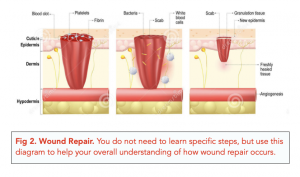
- The mucous membranes form a chemical primary defence. Exposed parts of the body are at risk of pathogen entry. These areas include the oral passages, nasal passages, eyes and ears. Goblet cells secrete mucous, which traps pathogens, and ciliated cells sweep them back out. These trapped organisms can be removed from the body via expulsive reflexes, which include coughing, sneezing, and vomiting. They occur automatically when a certain part of the body is irritated e.g. sneezing occurs when the respiratory tract is irritated by dust.
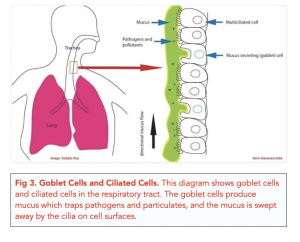
- The gut has a chemical primary defence and its own flora. The highly acidic environment of the stomach, due to the production of gastric acid, helps destroy many pathogens which may have been ingested. Other parts of the digestive tract, especially the colon, also has its own microbiota or gut flora, which prevents the proliferation of harmful pathogens.
Primary Defences in Plants
Plants also have both physical and chemical defences have pathogens.
- Physical defences in plants include having a waxy cuticle and cell walls, and the production of callose.
- The waxy cuticle acts as a barrier to pathogen entry. The leaves and stems of most plants have a waxy, protective layer over them called the cuticle. This layer makes it more difficult for pathogens to gain entry inside the plant. The cuticle also prevents collection of water on the plant, which reduces the transmission of pathogens between plants that grow in water.
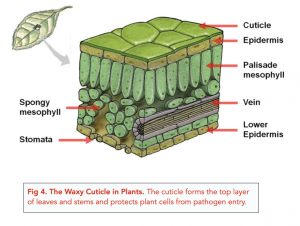
-
- Cell walls provide a secondary barrier to pathogen entry. Should any pathogens make it through the cuticle, it will face a second barrier i.e. the cell wall, before it is able to make it inside the plant cell itself.
- Callose can help block pathogen entry into, and in between, cells. During times of stress, e.g. infection, plants are able to secrete a polysaccharide called callose. They accumulate in cell walls and in between plasma membranes, which can help block pathogen entry into the cell. Callose can also be present at the plasmodesmata, which helps prevent the pathogen spreading from cell to cell.
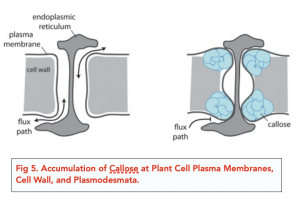
- Plant cells produce chemicals that are antimicrobial and/or toxic to insects.
- Plants can secrete chemicals which are antimicrobial to kill pathogens and prevent their growth. Plants can secrete saponins, which are chemicals that kill pathogens by e.g. destroying fungi cell membranes. Another chemical secreted by plants include phytoalexins, which can inhibit pathogen growth on the plant surface.
- Plants can produce chemicals which are poisonous to insects. Insects are less likely to feed on plants which produce toxins against them, thus, there is a decreased likelihood that the plant will be infected by viruses spread through insect vectors.
Primary Defences against Pathogens are the first line of defence that a plant or animal uses to protect itself from disease-causing microorganisms, such as bacteria, viruses, and fungi. These defences help to prevent or limit the spread of infections and protect the organism from harm.
Primary Defences against Pathogens are important in Biology because they play a critical role in maintaining the health and survival of organisms. By preventing or limiting the spread of infections, these defences help to ensure that organisms remain healthy and are able to continue functioning properly.
Some examples of Primary Defences against Pathogens in plants include physical barriers, such as the plant’s cuticle and epidermal cells, as well as chemical defences, such as antimicrobial compounds and phytohormones.
Some examples of Primary Defences against Pathogens in animals include physical barriers, such as the skin and mucous membranes, as well as chemical defences, such as antibodies and white blood cells.
Physical barriers act as Primary Defences against Pathogens in plants and animals by creating a physical barrier that prevents microorganisms from entering and causing harm. For example, the plant’s cuticle and epidermal cells provide a physical barrier that prevents pathogens from accessing the plant’s internal tissues, while the skin and mucous membranes in animals serve a similar function.
Chemical defences act as Primary Defences against Pathogens in plants and animals by producing chemical compounds that are toxic or inhibitory to microorganisms. For example, plants produce antimicrobial compounds that kill or inhibit the growth of pathogens, while animals produce antibodies and white blood cells that help to identify and neutralize pathogens.
Phytohormones play a role in Primary Defences against Pathogens in plants by regulating the plant’s response to infection. For example, certain phytohormones can trigger the production of antimicrobial compounds, which help to protect the plant from pathogens.
The immune system acts as a Primary Defence against Pathogens in animals by identifying and neutralizing pathogens that enter the body. This is achieved through a complex system of cells and proteins, such as white blood cells and antibodies, which work together to detect, target, and neutralize pathogens, helping to protect the animal from harm.





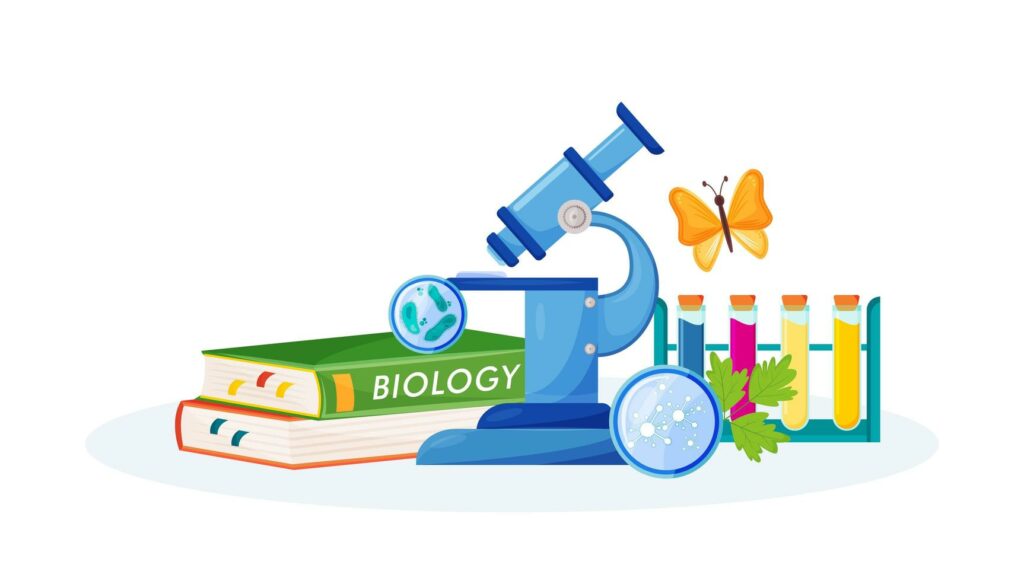
Still got a question? Leave a comment
Leave a comment